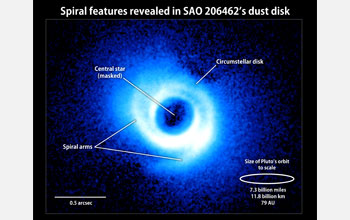SCIENCE
Spiral Arms Hint at the Presence of Planets
High resolution image of a young star with a circumstellar disks verifies predictions
A new image of the disk of gas and dust around a sun-like star has spiral-arm-like structures. These features may provide clues to the presence of embedded but as-yet-unseen planets.
"Detailed computer simulations have shown us that the gravitational pull of a planet inside a circumstellar disk can perturb gas and dust, creating spiral arms. Now, for the first time, we're seeing these features," said Carol Grady, a National Science Foundation (NSF)-supported astronomer with Eureka Scientific, Inc.
The newly imaged disk surrounds SAO 206462, a star located about 456 light-years away in the constellation Lupus. Astronomers estimate that the system is only about 9 million years old. The gas-rich disk spans some 14 billion miles, which is more than twice the size of Pluto's orbit in our own solar system.
"The surprise," said Grady, "was that we caught a glimpse of this stage of planet formation. This is a relatively short-lived phase."
A near-infrared image from the National Astronomical Observatory of Japan shows a pair of spiral features arcing along the outer disk. Theoretical models show that a single embedded planet may produce a spiral arm on each side of a disk. The structures around SAO 206462 do not form a matched pair, suggesting the presence of two unseen worlds, one for each arm. However, the research team cautions that processes unrelated to planets may also give rise to these structures.
"What we're finding is that once these systems reach ages of a few million years, their disks begin to show a wealth of structure--rings, divots, gaps and now spiral features," said John Wisniewski, a collaborator at the University of Washington in Seattle. "Many of these structures could be caused by planets within the disks."
Grady's research is part of the Strategic Exploration of Exoplanets and Disks with Subaru (SEEDS), a five-year-long near-infrared study of young stars and their surrounding dust disks using the Subaru Telescope atop Mauna Kea in Hawaii. The international consortium of researchers now includes more than 100 scientists at 25 institutions.
"These arm-like structures have been predicted by models, but have never before been seen," said Maria Womack, program director for the division of Astronomical Sciences at NSF. "It is the first observation of spiral arms in a circumstellar disk, and an important test for models of planetary formation."
